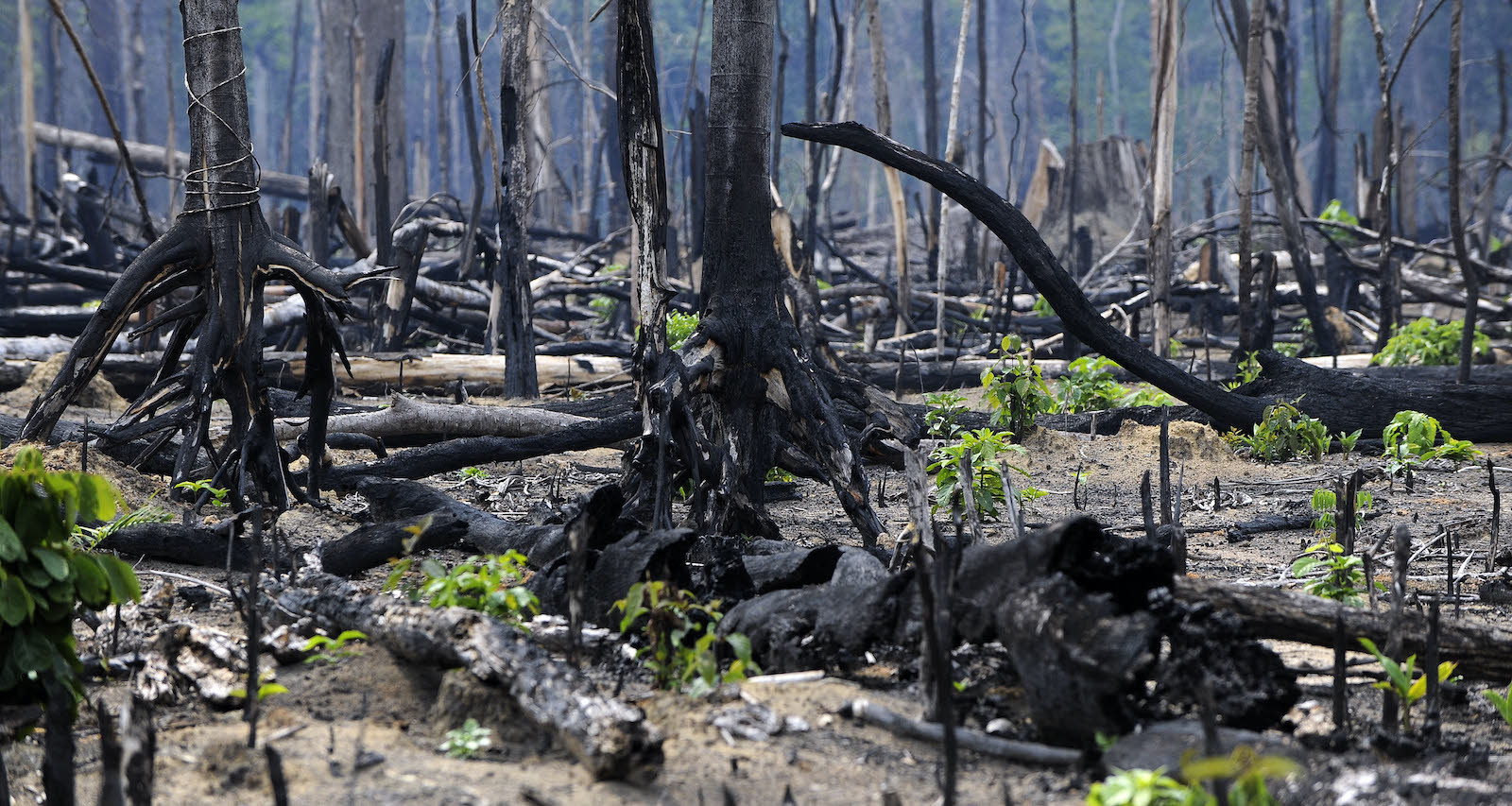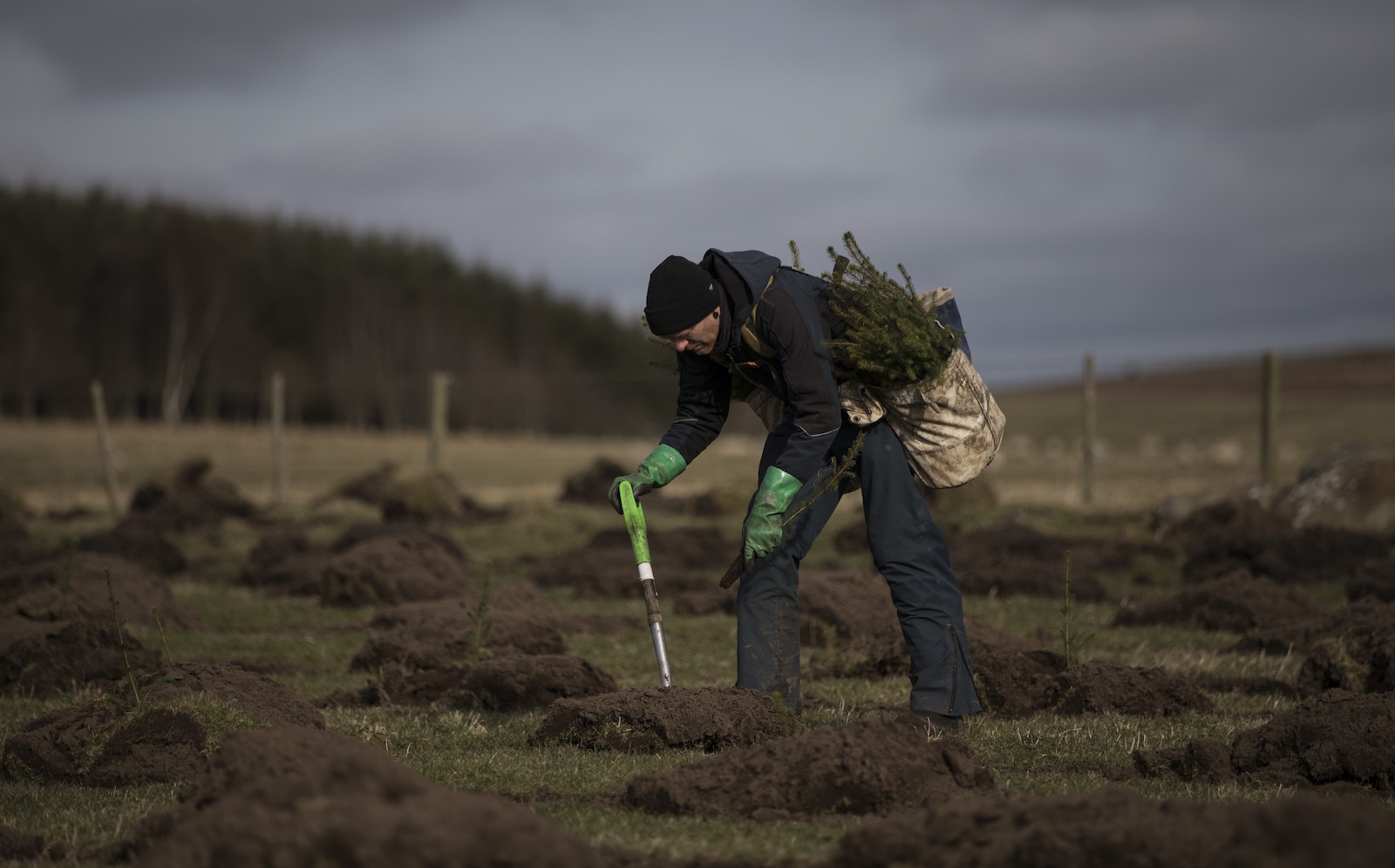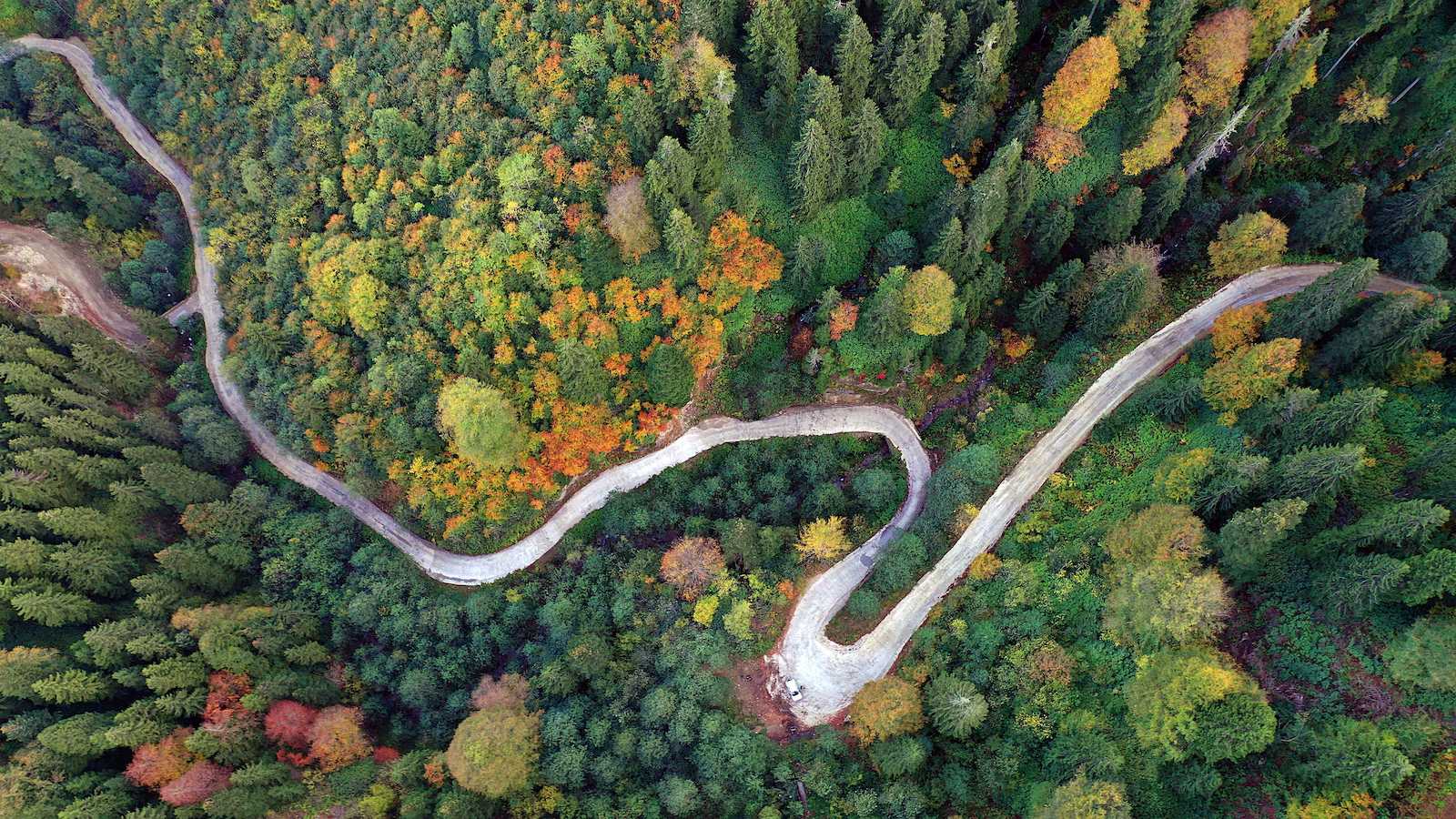This story was originally published by Yale Environment 360 and is reproduced here as part of the Climate Desk collaboration.
When Susan Cook-Patton was doing a postdoc in forest restoration at the Smithsonian Environmental Research Center in Maryland seven years ago, she says she helped plant 20,000 trees along Chesapeake Bay. It was a salutary lesson. “The ones that grew best were mostly ones we didn’t plant,” she remembers. “They just grew naturally on the ground we had set aside for planting. Lots popped up all around. It was a good reminder that nature knows what it is doing.”
What is true for Chesapeake Bay is probably true in many other places, says Cook-Patton, now at the Nature Conservancy. Sometimes, we just need to give nature room to grow back naturally. Her conclusion follows a new global study that finds the potential for natural forest regrowth to absorb atmospheric carbon and fight climate change has been seriously underestimated.
Tree planting is all the rage right now. This year’s World Economic Forum in Davos, Switzerland, called for the world to plant a trillion trees. In one of its few actions to address climate concerns, the Trump administration — with support from businesses and nonprofits such as American Forests — last month promised to contribute close to a billion of them — 855 million, to be precise — across an estimated 2.8 million acres.
The European Union this year promised 3 billion more trees as part of a Green Deal; and existing worldwide pledges under the 2011 Bonn Challenge and the 2015 Paris Climate Accord set targets to restore more than 850 million acres of forests, mostly through planting. That is an area slightly larger than India, and provides room for roughly a quarter-trillion trees.
The study found that natural regeneration can capture more carbon more quickly and securely than tree plantations.
Planting is widely seen as a vital “nature-based solution” to climate change — a way of moderating climate change in the next three decades as the world works to achieve a zero-carbon economy. But there is pushback.
Nobody condemns trees. But some critics argue that an aggressive drive to achieve planting targets will provide environmental cover for land grabs to blanket hundreds of millions of acres with monoculture plantations of a handful of fast-growing and often non-native commercial species such as acacia, eucalyptus, and pine. Others ask: Why plant at all, when we can often simply leave the land for nearby forests to seed and recolonize? Nature knows what to grow, and does it best.
Cook-Patton’s new study, published in Nature and co-authored by researchers from 17 academic and environmental organizations, says estimates of the rate of carbon accumulation by natural forest regrowth, endorsed last year by the U.N.’s Intergovernmental Panel on Climate Change, are on average 32 percent too low, a figures that rises to 53 percent for tropical forests.
The study is the most detailed attempt yet to map where forests could grow back naturally, and to assess the potential of those forests to accumulate carbon. “We looked at almost 11,000 measurements of carbon uptake from regrowing forests, measured in around 250 studies around the world,” Cook-Patton told Yale Environment 360.

New vegetation grows amidst burnt trees in the Amazon rainforest. Antonio Scorza / AFP via Getty Images
She found that current carbon accumulation rates vary by a factor of a hundred, depending on climate, soils, altitude, and terrain. This is much greater than previously assessed. “Even within countries there were huge differences.” But overall, besides being better for biodiversity, the study showed, natural regeneration can capture more carbon more quickly and more securely than plantations.
Cook-Patton agrees that as climate change gathers pace in the coming decades, rates of carbon accumulation will change. But while some forests will grow more slowly or even die, others will probably grow faster due to the fertilization effect of more carbon dioxide in the air, an existing phenomenon sometimes called global greening.
The study identified up to 1.67 billion acres that could be set aside to allow trees to regrow. This excludes land under cultivation or built on, along with existing valuable ecosystems such as grasslands and boreal regions, where the warming effects of dark forest canopy outweigh the cooling benefits of carbon take-up.
Combining the mapping and carbon accumulation data, Cook-Patton estimates that natural forest regrowth could capture in biomass and soils 73 billion tons of carbon between now and 2050. That is equal to around seven years of current industrial emissions, making it “the single largest natural climate solution.”
Cook-Patton said the study’s local estimates of carbon accumulation fill an important data gap. Many countries intent on growing forests to store carbon have data for what can be achieved by planting, but lack equivalent data for natural regeneration. “I kept getting emails from people asking me what carbon they would get from [natural] reforesting projects,” she says. “I had to keep saying: ‘It depends.’ Now we have data that allow people to estimate what happens if you put up a fence and let forest regrow.”
The new local estimates also allow comparisons between the potential of natural regrowth and planting. “I think planting has its place, for instance where soils are degraded and trees won’t grow,” she said. “But I do think natural regrowth is hugely underappreciated.”
The great thing about natural restoration of forests is that it often requires nothing more than human inaction. Nature is constantly at work restoring forests piecemeal and often unseen on the edges of fields, on abandoned pastures, in scrubby bush, and wherever forests lie degraded or former forest land is abandoned.
But because it requires no policy initiatives, investments, or oversight, data on its extent is badly lacking. Satellites such as Landsat are good at identifying deforestation, which is sudden and visible; but the extent of subsequent recovery is slower, harder to spot, and rarely assessed. Headline grabbing statistics on the loss of the world’s forests generally ignore it.
In a rare study, Philip Curtis of the University of Arkansas recently attempted to get around the problem by devising a model that could predict from satellite imagery what had caused the deforestation, and hence the potential for forest recovery. He found that only about a quarter of lost forests are permanently taken over for human activities such as buildings, infrastructure, or farming. The remaining three-quarters suffered from forest fires, shifting cultivation, temporary grazing, or logging, and at least had the potential for natural recovery.
Another study published this year found that such recovery was widespread and rapid even in an epicenter of deforestation such as the Amazon. When Yunxia Wang of the University of Leeds in England analyzed recently-released Brazilian data from the Amazon, she found that 72 percent of the forest being burned by ranchers to create new cattle pasture is not pristine forest, as widely assumed, but is actually recent regrowth. The forest had been cleared, converted to cattle pasture, and then abandoned, whereupon the forest returned so fast that it was typically only six years before it was cleared again. Such was the confusion caused by this rapid forest turnover that regular land-use assessments frequently wrongly categorized this new growth as degraded old-growth forest.
Wang noted that if Brazil’s President, Jair Bolsonaro, wanted to fulfill a promise made by his predecessor Dilma Rousseff at the 2015 Paris climate summit to restore 30 million acres of forest by 2030, then he need not plant at all. He could just allow regrowth to proceed in the Amazon without further clearing.
Brazil’s other great forest, the Atlantic forest, is already on that path, recovering slowly after more than a century of clearance for coffee and cattle. The government has an Atlantic Forest Restoration Pact that subsidizes landowners to replant, often with trees intended to supply the paper industry. Yet Camila Rezende of the Federal University of Rio de Janeiro says most of the forest regrowth is not from planting but from “spontaneous” regrowth, as forest remnants colonize neighboring abandoned farmland. She estimates that some 6.7 million acres of Atlantic Forest has naturally regenerated in this way since 1996. It now makes up about a tenth of the forest.
Much the same has been happening in Europe, where forest cover is now up to 43 percent, often from naturally recolonizing farmland rather than planting. Italy, for instance, has grown its forest cover by 2.5 million acres. In the former communist nations of central Europe, 16 percent of farmland in the Carpathian Mountains was abandoned in the 1990s, much of it reclaimed by the region’s famed beech forests. Across Russia, an area of former farmland about twice the size of Spain has been recolonized by forests. Irina Kurganova of the Russian Academy of Sciences calls this retreat of the plow “the most widespread and abrupt land-use change in the 20th century in the Northern Hemisphere.”
The United States has also seen natural forests regenerate as arable farmland has declined by almost a fifth in the past 30 years. “The entire eastern United States was deforested 200 years ago,” says Karen Holl of the University of California, Santa Cruz. “Much of that has come back without actively planting trees.” According to the U.S. Forest Service, over the past three decades the country’s regrowing forests have soaked up about 11 percent of national greenhouse gas emissions.

A worker plants Sitka spruce saplings at a reforestation project in Doddington, England in 2018. Dan Kitwood / Getty Images
With nature on the march, a major concern is whether a push for planting might grab land for plantations that natural forests might otherwise recolonize. The result would be less wildlife, less amenity for humans, and often less carbon stored.
Ecologists have traditionally dismissed the ecological gains from natural restoration of what is often called “secondary” forest. Such regrowth is often regarded as ephemeral, rarely sought out by wildlife, and prone to being cleared again. This has led many to regard planting to mimic natural forests as preferable.
Thomas Crowther, co-author of a widely-publicized study last year calling for a “global restoration” of a trillion trees to soak up carbon dioxide, emphasizes that, while nature could do the job in places, “people need to help out by spreading seeds and planting saplings.”
But a reappraisal is going on. J. Leighton Reid, director of Restoration Ecology at Virginia Tech, who recently warned against bias in studies comparing natural regeneration with planting, nonetheless told e360, “Natural regeneration is an excellent restoration strategy for many landscapes, but actively reintroducing native plants will still be a better option in highly degraded sites and in places where invasive species dominate.”
Others make the case that most of the time, natural restoration of secondary forests is a better option than planting. In her book, Second Growth, Robin Chazdon, a forest ecologist formerly at the University of Connecticut, says that secondary forests “continue to be misunderstood, understudied, and unappreciated for what they really are — young self-organizing forest ecosystems that are undergoing construction.”
Yes, she agrees, they are work in progress. But they generally recover “remarkably fast.” Recent research shows that regrowing tropical forests recover 80 percent of their species richness within 20 years, and frequently 100 percent within 50 years. That seems to be better than what human foresters achieve when trying to replant forest ecosystems.
Tree planting can worsen outcomes for everything from the number of bird and insect species to canopy cover.
A review of more than 100 tropical forest restoration projects by Renato Crouzeilles of the International Institute for Sustainability in Rio de Janeiro, with Chazdon as a co-author, found that success rates were higher for secondary forests allowed to regenerate naturally than for those subjected to the “active restoration” techniques of foresters. In other words, planting can often worsen outcomes for everything from the number of bird, insect, and plant species, to measures of canopy cover, tree density, and forest structure. Nature knows best.
Now, Cook-Patton has extended the reappraisal to the carbon-accumulating potential of natural forest regeneration. It too may often be superior.
This scientific rethink requires a policy rethink, says Holl. “Business leaders and politicians have jumped on the tree-planting bandwagon, and numerous nonprofit organizations and governments worldwide have started initiatives to plant billions or even trillions of trees for a host of social, ecological, and aesthetic reasons”.
She concedes that on some damaged lands, “we will need to plant trees, but that should be the last option, since it is the most expensive and often is not successful.”
Planting a trillion trees over the next three decades would be a huge logistical challenge. A trillion is a big number. That target would require a thousand new trees in the ground every second, and then for all of them to survive and grow. Once the cost of nurseries, soil preparation, seeding, and thinning are accounted for, says Crouzeilles, it would cost hundreds of billions of dollars. If natural forest growth is cheaper and better, does that make sense?




